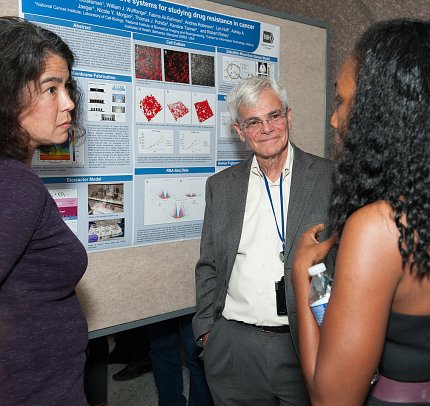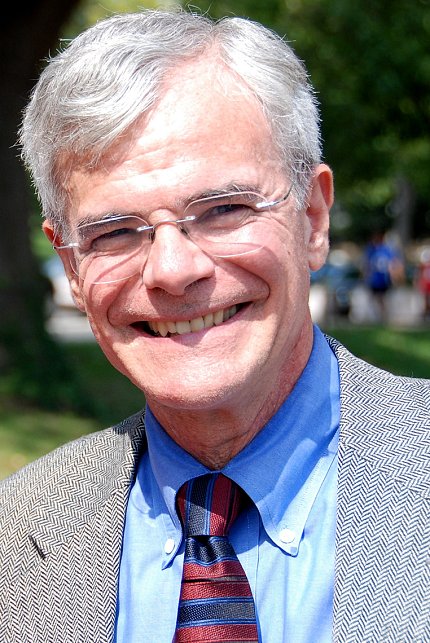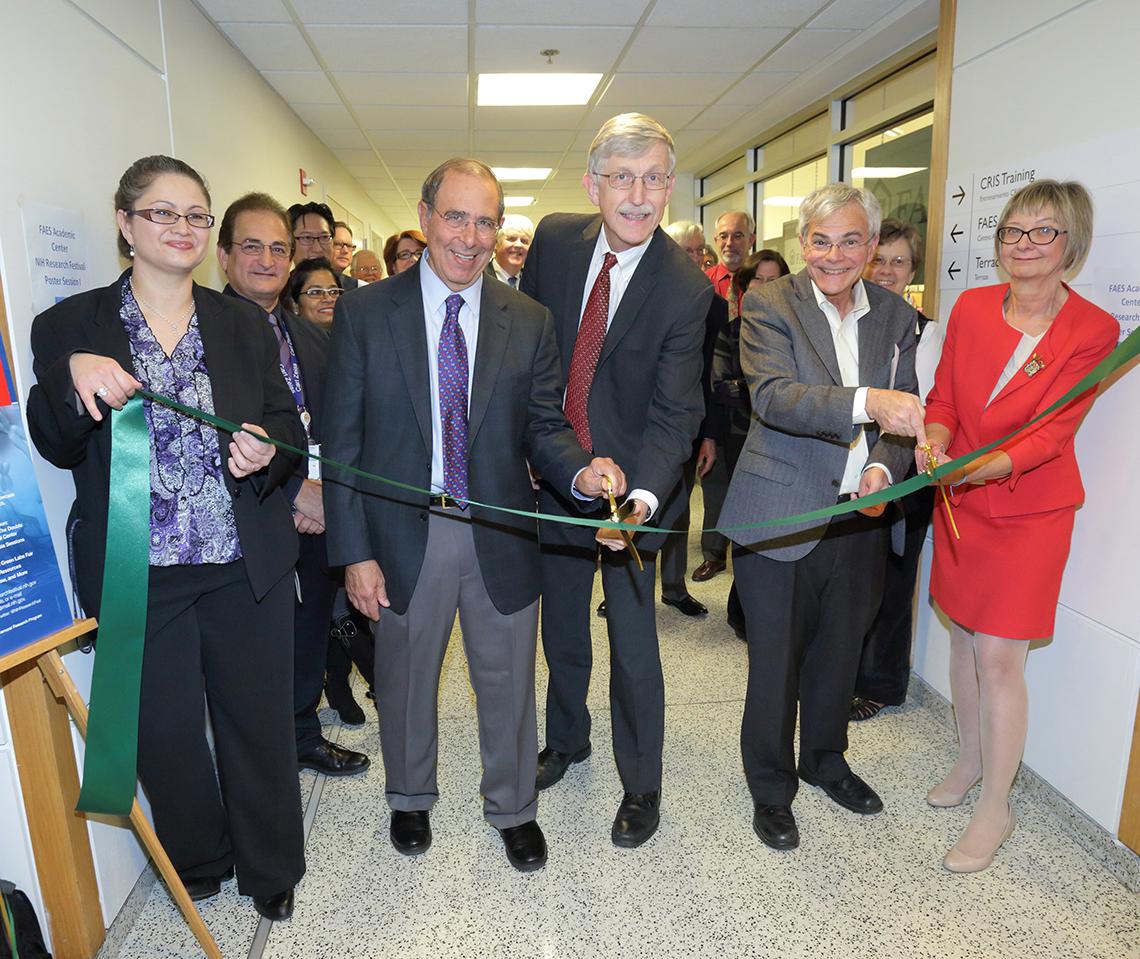After 29 Years as DDIR
Gottesman Returns to Lab Full Time, Leaves Intramural Research Legacy

When Dr. Michael Gottesman was named deputy director for intramural research (DDIR) officially in October 1994, he was already on his third or fourth post at NIH and he’d been acting DDIR for a year. Over the 29 years since then, he steered the Intramural Research Program (IRP) successfully through numerous challenges—most recently a worldwide pandemic that temporarily halted most in-person research in 2020.
In August, responding to what he called both a push and a pull, Gottesman, the longest-serving DDIR since World War II, stepped down to return full time to his NCI Laboratory of Cell Biology.
“There were a lot of considerations,” he said. “One of them was my advancing age—I was 75 last October…It seemed reasonable to me that somebody earlier in their career would be a better match for the job, which is very stressful and very time consuming. That was the push. The pull was my lab.
“I waited and waited and waited for cancer to be cured so I wouldn’t have anything to do,” he quipped, “but I really feel like I have some good science left in me. We often talk about thinking globally and acting locally. I’ve been thinking globally now for 29 years and it’s time to act locally within my own laboratory.”
Historic Legacy at IRP
Gottesman logged nearly 3 decades in the DDIR hot seat. He served under 3 NIH directors—7, if you factor in those who have held the role on an interim basis. For perspective on his extraordinary tenure, you have to look back at the medical research environment at the time.
In 1994, NIH’s IRP had been under close scrutiny for several years. Everything from its percentage of the NIH budget to peer review of its science had been appraised—often publicly, in the media. In fact, a congressionally mandated panel had that spring issued 42 recommendations for improving the IRP.

“The intramural program was receiving quite a bit of criticism,” recalled former NIH director Dr. Harold Varmus, who appointed Gottesman as DDIR. “There were many on the outside who were critical. Some of that was related to the fact that success rates for extramural grantees were low and people were jealous of the intramural program and concerned about how rigorously it was being managed.
“What I needed was somebody I knew and trusted well—Michael and I knew each other and had for a long time—somebody who was highly respected as a critical scientist, someone with a sense of humor, and importantly, somebody who was deeply devoted to the intramural program and its success,” Varmus said. “Michael had already displayed his ability to run something—he had been the acting director of the Human Genome Center, while they were waiting for a new director—and I respected and liked him immensely. One of the first things I did [as NIH director] was my effort to seduce Michael to take the position, sitting outside of Bldg. 1 on a day in September 1993. Happily, he gave it some thought and decided to do it. Ever since then, he’s prospered dramatically in the job because he is a good manager. He listens to everybody. Everybody likes Michael. And he’s a superb scientist and a very good human being.”
Following a Blueprint
Gottesman, who had served on one of several committees evaluating the IRP, took the list of recommendations as marching orders.
“That report was pretty much a blueprint for changes that would be made in the intramural program to sort of update it a bit,” Gottesman said, “to make sure it still had its cutting edge, make sure it could still recruit outstanding scientists.”
Within 5 years, he had overseen implementation of everything in the “big red book” (as the recommendations came to be called)—a stronger tenure system had been devised, the Clinical Center was being renewed, training for the next generation of biomedical investigators had been expanded and opened to a more diverse community.

NIDA scientific director Dr. Amy Hauck Newman first met Gottesman when he invited her to lunch after she gave a Director’s Seminar Series talk in 1996.
“I was a ‘rare bird’ in those days at the NIH–a female medicinal chemist, working on medications to treat cocaine use disorder, with 3 children, 6 and under,” she recalled. “Nevertheless, that invitation, first to give a talk in Wilson Hall and then to have lunch with the DDIR, was empowering. Over the years, I rose through the ranks of NIDA, had a few occasions to interact with Michael again, and finally became the SD in November 2020. He told me then that when he first met me, he expected that this would be my path. The fact that Michael likely empowered hundreds if not thousands of young tenure-track investigators, PIs and ultimately SDs over the 29 years he served as DDIR is both remarkable and highly laudable. He is certainly a diamond in the (NIH) rough.”
Among the gnarly terrain Gottesman has had to navigate are various issues that tend to capture headlines and create headaches: investigators’ honoraria and potential conflicts of interest, use of stem cells in research, patient safety and the culture of research at the Clinical Center and allocation of resources to early-career scientists versus long-term veterans.
“Michael’s brilliance is evident from his impeccable memory and in-depth knowledge of nearly every scientific topic studied at the NIH,” said former NIH director Dr. Francis Collins, in a statement following Gottesman’s announcement to step down. “His experience in running a laboratory with a focus on cancer has kept him keenly aware of the goals and needs of NIH’s scientific staff, including clinicians. One certain key to Michael’s success as DDIR has been his own experience as a physician-researcher at NIH.”
Half Century of NIH Experience
In 1971, just a year after graduating from Harvard Medical School, Gottesman was recruited as a Public Health Service “Yellow Beret” into NIH’s Research Associates Program.
“NIH was the premier place for medical research in the 70s,” he observed. “And I would warrant it still is, but there there’s more competition now than there used to be.”
Despite his awareness of NIH’s stellar reputation, Gottesman made his rounds before making his leap.

“I talked to a lot of people, met with a lot of people,” he remembered. “I found somebody who I really liked. That’s Marty Gellert…It was a fantastic experience for me. I had done some research before in summers and so on, but Marty is a quintessential scientist. He’s very rigorous, he’s very creative. He gave me a lot of freedom in the laboratory.”
After 3 years in what was then the National Institute of Arthritis and Metabolic Diseases (now NIDDK), Gottesman left NIH to finish his medical residency. The career die had been cast, however. He’d loved science from an early age—dabbling in rocket science as a kid, even—and his NIH stint sealed the desire to pursue medical science.
“I thought it was going to be some combination of practice and basic research, with the emphasis on basic research,” he said. “When I did the research in the laboratory, I always thought, well, one day this will bear fruit and will be clinically relevant. I think every physician who does research has that in the back of his or her mind, that maybe one day I’ll be able to treat patients with what I’m learning in the laboratory.”
Tangible Returns
Gottesman returned to NIH in 1976, earning a tenure-track lab post at the widely acclaimed NCI Laboratory of Molecular Biology founded by NIH legend Dr. Ira Pastan.

“It’s important to point out some of the things that Michael has done along the way that have been particularly important,” said Varmus, who also trained at NIH under Pastan. “One is persuading the scientific directors, who can be quite independent minded, to improve the rigor of their review of intramural programs. He helped to get the Stadtman [Tenure-Track Investigators] Program put in place. That has had a huge effect on the quality of new scientists in the program. And he did a great job in improving the number of graduate students working on the NIH campus, in finding ways for students in many graduate programs around the country to come to NIH and do their thesis work. That also led the way to the creation of the [NIH] Oxford-Cambridge Scholars Program.”
His colleagues and associates unanimously say Gottesman’s success as DDIR stems naturally from his personality.
“I saw Michael bring the perspectives of an outstanding scientist to the position of DDIR, as did his predecessors before him,” said Dr. Richard Wyatt, deputy director of NIH’s Office of Intramural Research who has been Gottesman’s close advisor in the job from the beginning. “He also had the distinctive capacity and patience to listen to intramural researchers with calmness, compassion, civility, fairness, humility and wisdom. It was an honor to support him in his role as DDIR for nearly 30 years.”
Dr. Lawrence Tabak, performing the duties of NIH director, noted that Gottesman has left his own blueprint for the job.
“With his contagious optimism, adept problem-solving attitude and wise policymaking, Michael has created a strong and living legacy to guide the future DDIR,” said Tabak. “The programs he developed have touched every stage of a scientific career—from high school and college internship programs, graduate studies, and postdoctoral training, to recruitment, career development, tenure, and emeritus transition of faculty. His leadership will be remembered in many things, including the remarkable improvements seen in research integrity and the recruitment and subsequent achievements of a diverse scientific workforce.”

